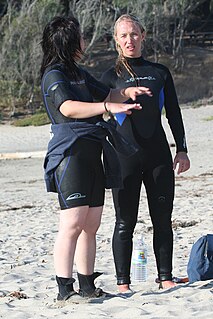 W
WAn alaia is a thin, round-nosed, square-tailed surfboard ridden in pre-20th century Hawaii. The boards were about 200 to 350 cm long, weighed up to 50 kg (100 lb), and generally made from the wood of the Koa Tree. They are distinct from modern surfboards in that they have no ventral fins, and instead rely on the sharpness of the edges to hold the board in the face of the wave.
 W
WA foilboard or hydrofoil board is a surfboard with a hydrofoil that extends below the board into the water. This design causes the board to leave the surface of the water at various speeds.
 W
WGrain Surfboards is an American company based in York, Maine that manufactures hollow wooden surfboards. The surfboards are made primarily from northern white cedar, with some western red cedar added for color accent. Grain manufactures custom boards, as well as selling kits and offering classes where surfers can build their own boards.
 W
WA kneeboard is a board ridden in a kneeling stance. Kneeboards are ridden in ocean surf, or while being towed behind a boat on a lake or river.
 W
WMr. Zog's Sex Wax is a Carpinteria, California, brand of surfwax manufactured for use on surfboards. This wax is rubbed on the top surface or "deck" of a surfboard to allow traction and grip for the surfer.
 W
WJack O'Neill was an American businessman, often credited with the invention of the wetsuit, and the founder of the O'Neill brand.
 W
WA surfski is a type of kayak in the kayaking "family" of paddling craft. It is generally the longest of all kayaks and is a performance oriented kayak designed for speed on open water. The distinguishing characteristic of a surfski is that it is primarily used for performance paddling in open water, most commonly the ocean, although it is well suited to all bodies of water and recreational paddling. The most common use of surfskis is in surf lifesaving competitions and downwind paddling.
 W
WA surfboard is a narrow plank used in surfing. Surfboards are relatively light, but are strong enough to support an individual standing on them while riding an ocean wave. They were invented in ancient Hawaii, where they were known as papa he'e nalu in the Hawaiian language, they were usually made of wood from local trees, such as koa, and were often over 460 cm (15 ft) in length and extremely heavy. Major advances over the years include the addition of one or more fins (skegs) on the bottom rear of the board to improve directional stability, and numerous improvements in materials and shape.
 W
WA surfboard fin or skeg is a hydrofoil mounted at the tail of a surfboard or similar board to improve directional stability and control through foot-steering. Fins can provide lateral lift opposed to the water and stabilize the board's trajectory, allowing the surfer to control direction by varying their side-to-side weight distribution. The introduction of fins in the 1930s revolutionized surfing and board design. Surfboard fins may be arrayed in different numbers and configurations, and many different shapes, sizes, and materials are and have been made and used.
 W
WA leg rope or surfboard leash is a urethane cord attached to the deck of a surfboard, down near the tail. It prevents the surfboard from being swept away by waves and stops runaway surfboards from hitting other surfers and swimmers. Modern leashes consist of a urethane cord where one end has a band with a velcro strap attached to the surfer's trailing foot, and the opposite has a velcro strap attached to the tail end of the surfboard. Should the surfer fall while riding a wave, the surfboard will not be swept away, thus allowing the surfer to quickly recover his surfboard and return to the take-off zone.
 W
WA surfboard lock is a device or a mechanism for securing a surfboard to prevent theft or loss. Typically surfboard locks attach to some part of the surfboard, such as the leash plug or center fin box slot. Alternately, some locking devices clamp or strap around the surfboard. Once the board is secured, the locking device attaches to some hard point like a vehicle or a non-movable object.
 W
WSurfboard wax is a formulation of natural and/or synthetic wax for application to the deck of a surfboard, bodyboard, or skimboard, to keep the surfer from slipping off the board when paddling out or riding a wave. It is also used to increase grip on the paddle of a surf kayak or dragon boat.
 W
WA tunnel fin is a type of surfboard fin used on surfboards, especially heavy longboards and longboard guns. The weight and length of these boards make it easier to control the fore and aft angle of the tunnel. As the name suggests it is shaped like a tunnel. Tunnel fins were first used by Richard Deese and Bob Bolen in California during the late sixties and continue to be developed by shapers today.
 W
WSurfboard wax is a formulation of natural and/or synthetic wax for application to the deck of a surfboard, bodyboard, or skimboard, to keep the surfer from slipping off the board when paddling out or riding a wave. It is also used to increase grip on the paddle of a surf kayak or dragon boat.
 W
WA wetsuit is a garment worn to provide thermal protection while wet. It is usually made of foamed neoprene, and is worn by surfers, divers, windsurfers, canoeists, and others engaged in water sports and other activities in or on water, primarily providing thermal insulation, but also buoyancy and protection from abrasion, ultraviolet exposure and stings from marine organisms. The insulation properties of neoprene foam depend mainly on bubbles of gas enclosed within the material, which reduce its ability to conduct heat. The bubbles also give the wetsuit a low density, providing buoyancy in water.